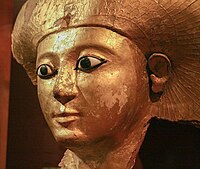Satdjehuti
| Satdjehuti in hieroglyphics | ||||||||||||||
|---|---|---|---|---|---|---|---|---|---|---|---|---|---|---|
S3t Ḏḥwty (S3t Jbw) daughter of Thoth |
||||||||||||||
|
Coffin mask of the Satdjehuti-Satibu ( State Collection of Egyptian Art Munich , ÄS 7163) |
||||||||||||||
Satdjehuti (also Sitdjehuti , Satdjehutisatibu [Sat-Djehuti-sat-Ibu] or Sitdjehutisitibu [Sit-Djehuti-sit-Ibu]) was a queen of the late Egyptian 17th dynasty .
Identity and name
The name of the Satdjehuti appears once on the Turin shroud of the "king's daughter" Ahmose (Turin 63001) from her grave QV47 in the Valley of the Queens and once with the nickname "Satibu" on her coffin mask (ÄS 7163). On the coffin mask she is referred to as the “King's Daughter” and “King's Sister” and on the shroud she is also referred to as “ King's Wife ”. It is very likely that both are the same person.
On the other hand, she is probably not identical to Queen Satdjehuti, of whom a gilded cardboard mask is known (BM 29779). It has other nicknames there.
The name of Satdjehuti means daughter of Thoth . The name of Thoth is also part of the proper name of the Seqenenre , which is translated as "Thoth is great". The word Ibu in their epithet is a short form of the Semitic word abu and means "father" (God). This word appears again in the middle of the 18th dynasty in the form Ibi and Ibaii and was probably chosen as a sign of loyalty to the Hyksos .
family
She was a daughter of the Tetisheri and therefore probably also of Senachtenre . Furthermore, she was a co-wife of the Seqenenre and the mother of the "king's daughter" Ahmose .
See also
literature
- Alfred Grimm, Sylvia Schoske: In the sign of the moon. Egypt at the beginning of the New Kingdom (= writings from the Egyptian collection . Volume 7 ). State Collection of Egyptian Art, Munich 1999, ISBN 3-87490-691-4 .
Web link
Remarks
- ^ Alfred Grimm, Sylvia Schoske: In the sign of the moon , 1999, p. 41
- ^ Alfred Grimm, Sylvia Schoske: In the sign of the moon , 1999, p. 82.
- ↑ The Hyksos who ruled Egypt at the time were of Semitic descent.
- ↑ Alfred Grimm, Sylvia Schoske: In the sign of the moon , p. 39-40.
- ^ Inscription coffin mask
- ^ Inscription of the Turin Shroud
- ^ Alfred Grimm, Sylvia Schoske: Imzeichen des Mondes , 1999, pp. 39–41.
| personal data | |
|---|---|
| SURNAME | Satdjehuti |
| ALTERNATIVE NAMES | Satdjehuti-Satibu |
| BRIEF DESCRIPTION | Wife of Seqenenre |
| DATE OF BIRTH | 16th century BC Chr. |
| DATE OF DEATH | 16th century BC Chr. |
